

(Available each month to Tile Heritage members who e-mail the Foundation from the address they
would like
E-News sent to. Contact: foundation@tileheritage.org)
PRINTED VERSION
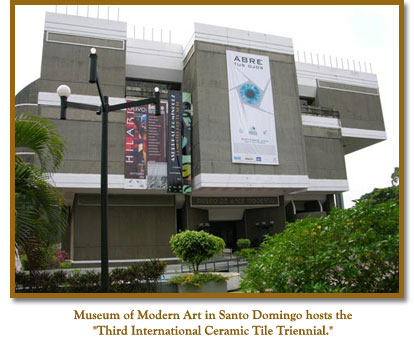
Here’s What’s Below:
Elit-tile Opens in Santo Domingo
Submissions Sought for New Tile Book
Pillars Workshop Report
Traipsing Through Michigan
Poem by Deborah Hechts
Tunisian Treasures
The Igneri Foundation/Art & Archaeology, the Museum of Modern Art,
the Altos de Chavon Cultural Foundation, and the Puntacana Group invites
you to the “Third International Ceramic Tile Triennial” (elit-tile) Inauguration Night,
November 16th, to be held at the Museum of Modern Art (MAM) of Santo Domingo,
the capital city of the Dominican Republic.
More than 255 works from artists representing 53 countries will be shown until
January 27, 2007. You are invited to the elit-tile exhibition and to attend the
festivities on Inauguration Night!
Visit www.elit-tile.net/home
Lark Books is taking submissions for an upcoming book, "500 Tiles," that will focus on ceramic tiles and mosaics.
The deadline is February 1st, 2007 and there is no entry fee. Angelica Pozo will serve as juror.
For more information: www.larkbooks.com/submissions
From Sheila Menzies
“Pillars in Clay,” a clay sculpture and majolica workshop, was held in Solana Beach,
California in early October directed by majolica artist Irene de Watteville. What fun
the eight of us had for two days! The workshop was held in support of “Keeping the
Craft Alive,” the workshop series presented each year by Tile Heritage.
Irene introduced participants to hand-building in clay and majolica techniques. Most
people were already familiar with clay as a medium but some were not.
As Irene had prepared some elements in advance, already bisqued and with a majolica
base glaze applied, we could experience painting with the majolica technique on these
pieces on day two, the third step in completing the pillars. The elements we were producing then
needed to be dried and bisque-fired prior to the application of glazes.
The beauty of maquettes - these miniature pillars – is that they are scale models
complete in themselves, but they can also be utilized in the future by transposing
them into full-size forms, large-scale garden sculptures, for example, if one chooses.
From Joe Taylor
Detroit can be a lovely place to visit in mid-August, especially when the weather cooperates.
The staff at Pewabic Pottery had scheduled a tile festival that weekend, the first of its kind
at the pottery itself; and not having seen many of our tile maker friends in several years,
I was anxious to reconnect.
Titled “Patterns of Detroit,” the 3000 square foot mural was created with the input of
27 community groups. Hubert Massey, a local muralist, designed the central panel, which
depicts a mother and child surrounded by important neighborhood landmarks. The mother
works to bind together colorful patterns representing the various cultures in the city.
The fabric winds through the central images and spills out into horizontal panels, each
produced by a different local school or nonprofit organization. The mural was dedicated
on October 5, 2005.
The white tent raised out front at the Pewabic Pottery served as a suitable attraction
for passers-by on East Jefferson. I would guess perhaps 600 people paid the modest fee
to enter the sale area. Probably 25-30 tile artists were present with their work, many
of whom were friends, both current and former members of Tile Heritage. In suitable
contrast Kathy Rae occupied the largest space with her wide variety of historic tiles.
Terese Ireland, executive director at Pewabic, treated me to a delightful lunch downtown
in the shadow of the new Tiger Stadium, where we occupied ourselves talking tiles, not
baseball. She must have rigged the raffle as I won the first drawing!
Royal Oak, Michigan, about 11 miles north of downtown Detroit, has been for some years
a growing community preferred by those who wish to live and raise their families outside
of the city. It’s now a haven for tilemakers. Last year Marcia Hovland and her husband
Denis DeSandre purchased retail space on Fourth Street and have since opened a studio/gallery
where Marcia makes her one-of-a-kind tiles and sells an assortment of handmade tiles from
around the country. For more than ten years Marcia has specialized in hand-making tiles
with whimsical subjects: bugs, bees, fairies, mermaids and nature scenes. She also makes
beaded bracelets, ceramic buttons and bowls.
Friend and fellow tilemaker Laurie Eisenhardt is not far away. Laurie’s studio behind
her early 20th century home is surrounded by a lush, well-kept flower garden, accented
by an intimate patio snuggled in back for the family barbeque. Recently, Laurie was
commissioned to provide a series a decorative 12 x 12 tiles for the newly built
Southfield (Michigan) Public Library. The tiles, each with a different children’s theme,
are inset in the circular wall around the outdoor garden designed with special plantings
and sculpture for young people to enjoy. The library also has a comfortable reading area
with a large fireplace and hearth adorned with Pewabic tiles.
While in Royal Oak don’t miss a visit to the Detroit Zoo where tilemaker Gretchen Kramp,
another local artist, has two sizeable murals. The first, installed in 2000, takes up a
wall of the entry to the National Amphibian Conservation Center. The other, produced two
years later, adorns the entrance of the Nunavut Gallery in the Arctic of Life exhibit.
A large polar bear stands under the motto Nunatsiaq, meaning “the beautiful land” in Inuit.
If you ever plan to visit Motawi Tileworks in Ann Arbor, don’t try to get there from Detroit.
Driving west out of the city, it takes forever, even without traffic. You’re sure you’re going
to drop into Lake Michigan before you get there. I suggest you use the phone or
visit the website at www.motawi.com. It’ll be a lot faster
and you won’t make the mistake of
turning north on Rt. 23 and getting lost! (Lesson: never leave home without Mapquest in your back pocket.)
We’ve all heard about the two-car garage where the company started in the early ‘90s, and
we choose to forget the cramped, dark quarters on Staebler as producers of Arts and Crafts
products need a “clean and well-lighted” place to work.
Putting aside the beauty and exquisite craftsmanship of the individual decorative tiles, one
has to marvel at how the staff manages the keep track of the myriad of choices available to
customers, considering the number of decorative options, glaze choices, trim shapes and sizes.
For any other company this would prove to be a nightmare. At Motawi it’s now all part of the
routine, and you can tell by the look of their faces—everyone’s.
Custom Design on Tile, Bloomfield Hills, Michigan
whose oldest son was married this past summer.
A gift-a skill-a ball of clay
To push and pull and form unending
Eventually with lots of time
A gift-a seed-a ball of life
Feed and clean with care unending
When he’s ready to depart
A life of art the art of living
I am writing to tell you about a recent travel experience that might be something to
share with the THF membership. My husband Peter Handler and I, both artists, toured
Tunisia last summer on our honeymoon, and we met and worked with some incredible
ceramic artists and crafts people. This is a country that few Americans visit and it's
fascinating! It is a treasure trove for anyone interested in tile!
We also met people everywhere. I spent an afternoon doing claywork with a Berber
family of women potters in the pottery village of Sejnane, to tour the pottery town
of Guellala on the island of Djerba, and to make a small tile mural in a ceramic
workshop in Nabeul, center of Tunisian ceramics manufacturing.
Peter makes studio furniture. He is well known nationally in the craft community as
he has been exhibiting
Karen is organzing a 14-day ceramics and cultural tour of Tunisia for Spring 2007.
If you are interested, karensinger@karensinger.com
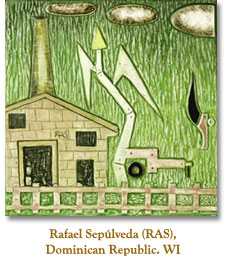
Open Invitation to elit-tile!
New Tile Book from Lark. Submissions Sought
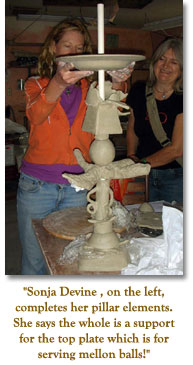
“Pillars in Clay”: Workshop Extraordinaire!
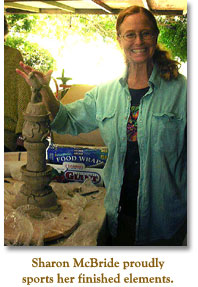 On the first day we designed our ideas for pillars and worked on creating individual, hollow clay
elements to complete our maquettes, most less than two feet tall. Each pillar was
‘strung’ on a length of pipe embedded in a cement base. By the end of the first day
the pillars were taking shape.
On the first day we designed our ideas for pillars and worked on creating individual, hollow clay
elements to complete our maquettes, most less than two feet tall. Each pillar was
‘strung’ on a length of pipe embedded in a cement base. By the end of the first day
the pillars were taking shape.
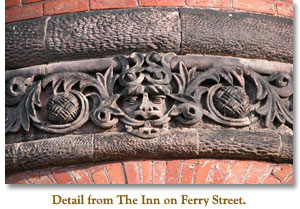
Traipsing Through Michigan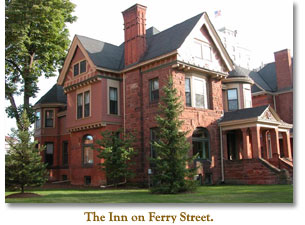 Finding a reasonable round trip out of San Francisco, I made a reservation at The Inn on
Ferry Street, a series of four restored Victorian houses in Midtown, just a few blocks
from three major tile treasures: the Detroit Institute of Arts (Enfield tiles and the
Dragon of Marduk from Babylon’s Ishtar Gate), the Detroit Public Library (Pewabic tiles
and mosaics and a large mural by Millard Sheets), and a massive Hubert Massey designed
mural at the intersection of Brush and Kirby.
Finding a reasonable round trip out of San Francisco, I made a reservation at The Inn on
Ferry Street, a series of four restored Victorian houses in Midtown, just a few blocks
from three major tile treasures: the Detroit Institute of Arts (Enfield tiles and the
Dragon of Marduk from Babylon’s Ishtar Gate), the Detroit Public Library (Pewabic tiles
and mosaics and a large mural by Millard Sheets), and a massive Hubert Massey designed
mural at the intersection of Brush and Kirby.
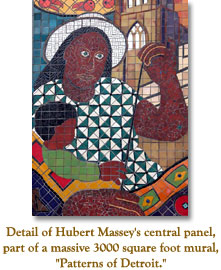

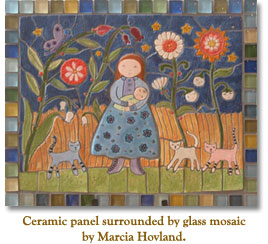

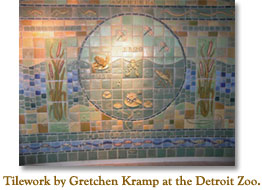
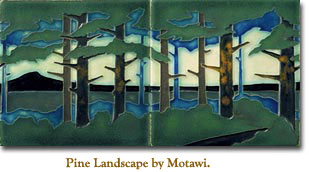
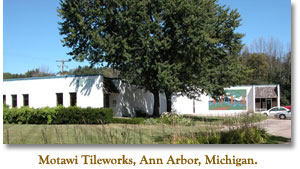
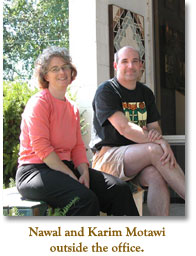 Motawi Tileworks today fits the bill.
Located in the mid-Michigan countryside, in a natural setting west of Ann Arbor,
the factory
would blend right in were it
not for its white exterior and the massive Pine Landscape mural,
inspired by Grueby Faience’s “The Pines” and now a Motawi trademark, painted on the building’s façade.
Motawi Tileworks today fits the bill.
Located in the mid-Michigan countryside, in a natural setting west of Ann Arbor,
the factory
would blend right in were it
not for its white exterior and the massive Pine Landscape mural,
inspired by Grueby Faience’s “The Pines” and now a Motawi trademark, painted on the building’s façade.
A Gift: A Poem by Deborah Hecht
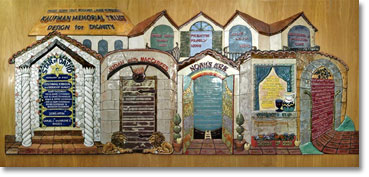
A GIFT
To have the will to see the way
To find the statement it can say
Deal with mess and constant mending
Build it up and carve it down
Pick it up if it falls down
And don’t give up until it’s done
Let it dry and slowly bake it
With some luck the kiln won’t break it
Add some color fire it in
Over and over and over again
Comes the vision once in mind
But when it’s art it isn’t mine
Although I sowed I cannot reap it
Even if I want to keep it
It’s lost if others cannot see it
To hold and love in need and strife
Nurture guidance firm but gentle
Find within his full potential
Children need a lot of tending
Build him up so he’ll be strong
Scold him gently when he’s wrong
Pick him up when he falls down
Help him choose but don’t choose for him
He needs to handle what’s before him
School will test him I’ll adore him
And seize the world with all his heart
The day comes soon in little time
My son’s the man I had in mind
He has to leave he isn’t mine
I must let him go for life
To journey forward with a wife
Joy and sorrow interweaving
Borrowed treasure fleeting pleasure
To give to get and not to measure
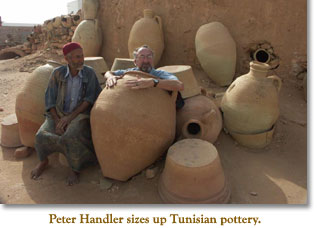
Tunisian Treasure Trove: A Report from Karen Singer
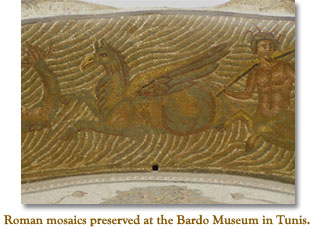 We were both fascinated and impressed with the range of work in Tunisia that is of
interest to craftspeople, especially ceramists. This ranges from extensive Roman
mosaics and the Islamic and Spanish inspired tilework that is installed all over
the country to the work being done today. Everywhere you look, there is tile work -
on the mosques, in the streets, on the ceilings, walls and floors in both rich and poor
areas. We saw the Bardo Museum in Tunis, with perhaps the biggest collection of Roman
mosaics in the world, and two ancient Roman cities, Bulla Regia and Dougga,
We were both fascinated and impressed with the range of work in Tunisia that is of
interest to craftspeople, especially ceramists. This ranges from extensive Roman
mosaics and the Islamic and Spanish inspired tilework that is installed all over
the country to the work being done today. Everywhere you look, there is tile work -
on the mosques, in the streets, on the ceilings, walls and floors in both rich and poor
areas. We saw the Bardo Museum in Tunis, with perhaps the biggest collection of Roman
mosaics in the world, and two ancient Roman cities, Bulla Regia and Dougga,
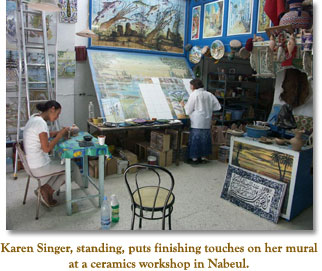 where
mosaics are intact in the walls and floors of numerous buildings.
where
mosaics are intact in the walls and floors of numerous buildings.
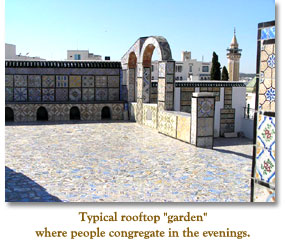 in high end craft shows for about 30 years. His web address
is: www.handlerstudio.com. I am a sculptor/ceramic tile maker - in business since 1991 -
my business name is Karen Singer Tileworks, Inc. My three person staff and I make
large-scale ceramic tile murals, most of which are installed in hospitals, universities,
and other non-profits across the country as donor recognition walls. My web address is: www.karensinger.com.
in high end craft shows for about 30 years. His web address
is: www.handlerstudio.com. I am a sculptor/ceramic tile maker - in business since 1991 -
my business name is Karen Singer Tileworks, Inc. My three person staff and I make
large-scale ceramic tile murals, most of which are installed in hospitals, universities,
and other non-profits across the country as donor recognition walls. My web address is: www.karensinger.com.